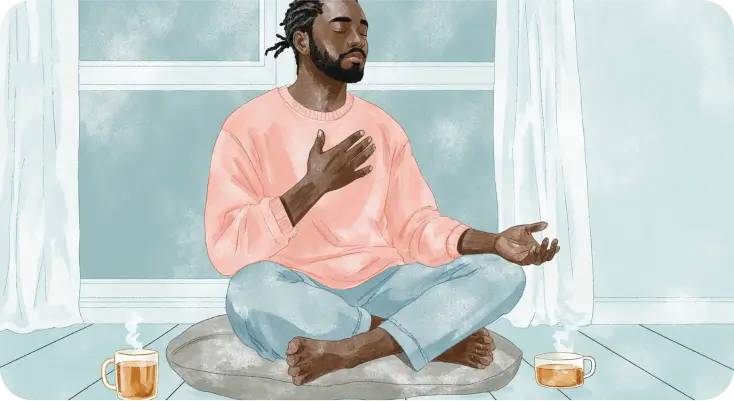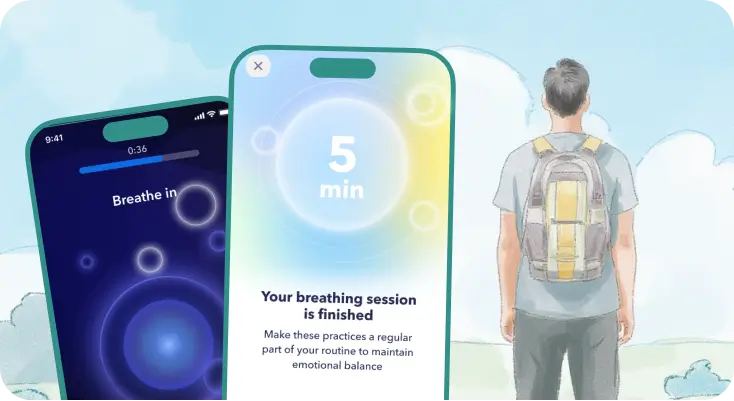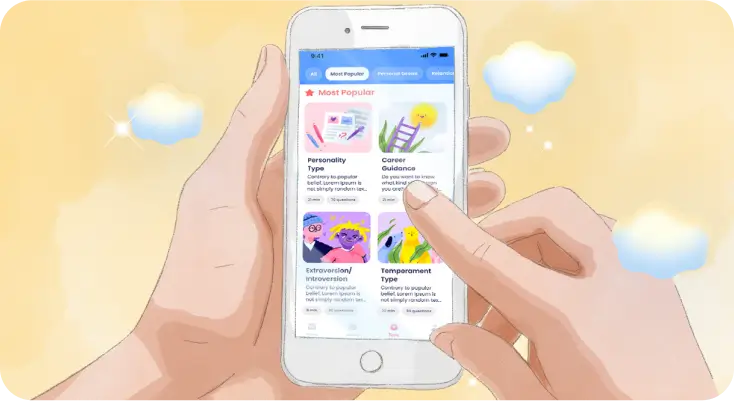Have you ever found yourself standing in the kitchen, wondering whether you actually boiled the water or just imagined it? Do you ever go back and wonder if you packed your bag or locked the door?
Maybe you were scrolling your phone while eating, thinking about work while walking, or having a conversation while planning dinner in your head. It’s like you’re living your life but not really living in it.
Our life makes it incredibly easy to disconnect from the present moment and run on autopilot. Our bodies often move through the motions while our minds wander far, replaying the past, rehearsing the future, worrying, and planning. But as a result, we miss the only thing that’s truly real: right now.
Let’s learn what living in the present moment means and how to bring your full attention back to the present through mindfulness exercises.
If you’re not sure how connected you are to the present, take our short Well-Being Test to check in with yourself and see where you stand emotionally, mentally, and mindfully.
How to Learn to Live in the Moment?
Learning the skill of mindfulness is an ongoing process that requires awareness, patience, and practice. Here are helpful techniques to become fully engaged in your life:
1. Practice meditation and breathing exercises
Meditation allows you to calm your body and mind, get in touch with yourself, and free yourself from stress and anxiety, according to research on the influence of breathing practices [1]. Start with 5-10 minutes a day and gradually increase the time and frequency of practice. Here’s an example of a 3-minute breathing meditation:
Step 1
You can do this sitting or standing, but make sure to keep your shoulders relaxed and your back straight. Close your eyes. Then turn your attention to what’s going on inside you and accept it. To do this, ask yourself, “What am I feeling right now? What thoughts are going through my head?”
Try to treat your thoughts simply as events happening in your mind. It’s common to notice yourself getting distracted by your thoughts, so if this happens, bring yourself back to the present moment and feeling. If you feel discomfort or unpleasant sensations, don’t try to change them and simply feel your feelings instead of intellectualizing them.
Step 2
Focus on one spot and pay attention to how your belly feels as you breathe. Notice it rising when you inhale and falling when you exhale. Feel how the air moves through your body. Let each deep breath bring you back to the present moment. If your mind wanders, redirect your attention back to your breath.
Step 3
Now, try to expand your awareness around your breath to feel your body, including your posture and facial expression. Imagine as if your whole body is breathing. If you notice tension or discomfort, try to focus on these sensations, directing your breath there. When they no longer require your attention, return to the sensations of your body and continue to follow them.
2. Practice self-awareness
To live in the present and learn how to calm down and build resilience, you need to be more aware of your actions. For example, when you’re busy working, don’t daydream about what you’ll do after it’s over, but focus on one task and its completion.
When you eat, try not to be distracted by your phone, TV, or conversations, but focus on the taste, smell, texture, and color of the food. Try to feel the temperature of the water, the fluffiness of the foam, its aroma, and the smooth texture of the plate when you wash the dishes.
When you walk in the park, breathe in the fresh air, lift a yellowed autumn leaf, and touch the grass wet after the rain. You may not notice these things, but they can bring you back to reality, tear you away from negative thoughts and help to clear your mind and get rid of mental fog.

3. Accept your emotions
With self-awareness, you develop the ability to accept your emotions as they are, without fear or regret. This may help you stop worrying about everything, giving your negative emotions space to exist and pass naturally.
As a result, it’s also reducing reactivity. Mindfulness practices like mindful walking, single-tasking, and breathing exercises can help you notice patterns of behavior that may arise in response to emotions over and over again, according to a study on the effects of mindfulness on psychological health [2]. When you live in the moment, you can choose how to respond to every event in your life.
Here are a few more exercises to learn to accept your emotions:
1. Emotional regulation practice
Give yourself time before making important decisions or reacting to emotional events. Try this when you feel triggered, overwhelmed, or pressured to respond:
- Take a deep breath.
- Count to 10 slowly, or take a short walk.
- Ask yourself the following questions: What were you thinking about at these moments? What images and thoughts appeared in your head? What sensations did you have in your body? What did you do or want to do? Do you need more time to respond clearly?
2. Stress resilience exercise
Develop the ability to accept difficult situations from a calmer and more reasonable position, not allowing negative emotions to perpetuate additional stress:
- Pause and notice your initial emotional reactions, like tension, irritation, or worry.
- Recognize the difficulty without passing judgment: “This is a tough moment, and that’s okay.”
- Ask yourself: “What is one thing I can control right now?”
- Choose a small, reasonable action or thought that helps you stay grounded, such as focusing on your breath or taking a short break.
3. Practice to increase self-compassion
Mindfulness also helps you develop understanding and support for yourself in difficult moments. It may help you avoid strong criticism and not judge yourself for your own emotions or reactions.
You may try the following practice to let go of self-criticism, blame, and harsh judgment. Notice when negative self-talk shows up. It may be a moment when you start feeling worthless, downplaying your efforts, or replaying mistakes, thinking, “I feel like a failure”. When you catch it, pause and try to respond with compassion. Gently remind yourself: “I’m okay. I can handle this.” Support yourself as you would a close friend with patience, encouragement, and respect.
Want to become more aware of your emotional patterns? Try using a mood tracker with the Breeze app. Tracking your mood daily can help you notice triggers and shifts over time. It’s a simple but powerful way to support your emotional awareness and emotional regulation.

4. Try mindful listening
When talking to others, try to be fully present and listen attentively. Don’t interrupt or think about your response, just listen and understand the other person.
How to do it:
- Make eye contact and put away distractions like your phone.
- Don’t interrupt or rush to offer advice. Just listen.
- After they finish, pause before responding to take in what was said.
Mindful listening builds deeper connection and trust, which might improve your communication and closeness to others. It helps the other person feel truly heard and valued, which can strengthen relationships.
At the same time, it trains your attention and patience, helping you stay grounded in the moment instead of reacting automatically. This way of listening can help you talk to people better, clear up confusion, and have deeper conversations in your personal and professional life.
Do you find it difficult to listen patiently and actively without interrupting or thinking about what you’re going to say next?
5. Practice gratitude
Gratitude allows you to see the good things, appreciate what you already have, and not focus on the negative, according to research on the benefits of appreciation [3]. Try to list 3 things you are grateful for each day. For example, be grateful for your body, health, family, friends, work, hobbies, nature, music, or a great book you’re currently reading.
You can keep a gratitude journal, writing down various things you are grateful for every day. You can say thank you to people who do something good for you, or do something good for others, to spread gratitude.
Expert Insight
“A common practice that helps build mindfulness is movement. It requires attention and focus directed toward your body and the task at hand. Whether it’s lifting weights, dancing, or playing tennis with a friend, finding movement you enjoy can help you build mindfulness and increase your ability to live in the present moment.”
Hannah Schlueter
Mental health professional
How to Implement Living in the Present In Daily Life
To implement mindfulness into your daily routine and develop a new habit of focusing on presence, follow these simple rules:
1. Practice regularly
Find a few minutes a day to breathe and deepen an authentic connection with yourself. This time can be filled with mini-meditation or simply looking at objects in the distance.
Try customized routines in the Breeze app to track your consistency in regular exercises. You only need to plan it in Breeze Wellbeing and set a reminder and frequency. It’s much more convenient than printable habit trackers or apps that only let you have this one feature.
2. Try various approaches
Explore different techniques, such as meditation, yoga, breathing exercises, body scanning, and other mindfulness activities to find those that best suit your lifestyle and needs.
The Breeze app makes it easy to let go of worries with just a few simple steps. Open the app, choose Mindful Breathing, and follow the step-by-step guidance.
This practice reflects how your brain is wired to manage attention and filter out distractions. When you focus on your breath, you’re engaging a natural process in the brain that supports clarity and calm.

3. Join a practice with others
Join a group or a mindfulness class to immerse yourself in a motivating and supportive environment. Connecting with like-minded people who are also practicing mindfulness helps to maintain interest and motivation for the practice.
Breeze has social features that allow you to share your self-discovery test results with friends and family members. These quizzes provide insights into emotional intelligence, childhood trauma, relationships, career, personality type, and many other aspects of life. This way, you can gain a deeper understanding and get other people’s perspectives.

Remember that developing mindfulness is a process that takes time and effort. It is important to be patient and conscientious in your practice. While you do not need to be perfect, intentional effort will make the use of mindfulness easier and more habitual over time. Gradually, you will notice how mindfulness will begin to impact your life, improving your physical and emotional well-being and helping you to live in the present moment.
We asked Hannah Schlueter, MA, LAC, whether living in the moment can improve relationships and communication. Here’s her answer: “Absolutely! It is a great skill for building relationships and connecting with people on a deeper level. If you are looking to build relationships and improve your communication skills, incorporating mindfulness strategies will be a great asset.”
What Is Being in the Present Moment?
Being mindful is the ability to be aware and attentive to what is happening within and around you at the present moment. It means not being distracted by your thoughts, feelings, memories, fantasies, plans or expectations, but focusing on your breathing, sensations, sounds, smells and tastes.
Living in the moment means not resisting or over-emphasizing what you are experiencing, but simply observing and accepting it without judgment or criticism. It means not regretting the past or worrying about the future, but accepting reality as it is, not judging yourself and others, but treating yourself and the world around you with love and compassion.
Being in the present moment is not the same as living mindlessly or irresponsibly. You do not ignore your past or future, but you do not allow them to dominate the present. This allows you the ability to be the best version of yourself, free and happy, and live a full and quality life.
This is not just a philosophical idea. It is a practical skill that can be developed and improved. Research shows that being in the present moment improves mental health and psychological well-being, reduces stress, and helps to be more productive [4].
Sources
- Bentley TGK, D’Andrea-Penna G, Rakic M, Arce N, LaFaille M, Berman R, Cooley K, Sprimont P. “Breathing Practices for Stress and Anxiety Reduction: Conceptual Framework of Implementation Guidelines Based on a Systematic Review of the Published Literature. Brain Sci.” 2023
- Keng SL, Smoski MJ, Robins CJ. “Effects of mindfulness on psychological health: a review of empirical studies.”. 2011
- Sansone RA, Sansone LA. “Gratitude and well being: the benefits of appreciation. 2010.
- Kiken LG, Lundberg KB, Fredrickson BL. Being present and enjoying it: Dispositional mindfulness and savoring the moment are distinct, interactive predictors of positive emotions and psychological health. October 2017
Disclaimer
This article is for general informative and self-discovery purposes only. It should not replace expert guidance from professionals.
Any action you take in response to the information in this article, whether directly or indirectly, is solely your responsibility and is done at your own risk. Breeze content team and its mental health experts disclaim any liability, loss, or risk, personal, professional, or otherwise, which may result from the use and/or application of any content.
Always consult your doctor or other certified health practitioner with any medical questions or concerns
Breeze articles exclusively cite trusted sources, such as academic research institutions and medical associations, including research and studies from PubMed, ResearchGate, or similar databases. Examine our subject-matter editors and editorial process to see how we verify facts and maintain the accuracy, reliability, and trustworthiness of our material.
Was this article helpful?




